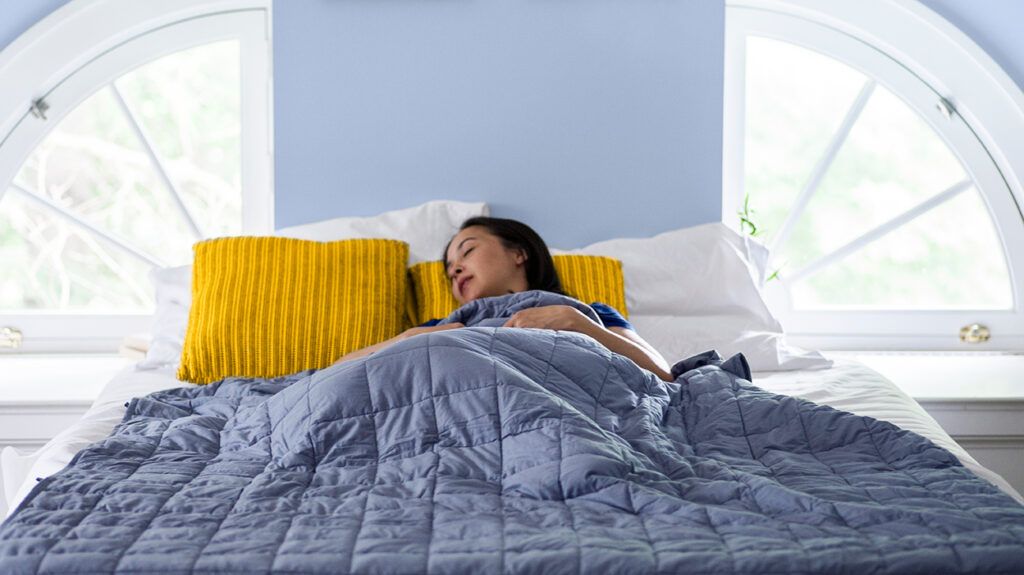
A weighted blanket can help you to get calm and rest. Some people say they can soothe the symptoms of ADHD.
For people living with attention deficit hyperactivity disorder (ADHD), the world can feel overwhelming. This common neurodevelopmental disorder affects the way you think, behave, and process stimuli.
The symptoms of ADHD can vary, but they may include:
- inattention
- trouble focusing
- hyperactivity
- forgetfulness
- impulsivity
These can take a toll on development and daily functioning.
Although ADHD is often diagnosed in childhood, many people – particularly women – aren’t diagnosed until much later in life. This might be because the condition often presents differently in women and girls. In 2019 in the United States, about
ADHD is treatable and responds well to a combination of medication, therapy, and behavior management techniques.
Some self-help strategies can also help you manage the symptoms. You can consider using a weighted blanket as a coping mechanism that can help you manage your ADHD symptoms.
A weighted blanket contains weighted pellets, balls, or other heavy materials. They typically weigh 5 to 30 pounds.
Weighted blankets are often recommended to treat many conditions, including:
- anxiety disorders
- insomnia
- ADHD
- autism spectrum disorders
They apply gentle yet consistent pressure across your body. Some say that using a weighted blanket feels like you’re being hugged.
It’s theorized that weighted blankets work similarly to a technique called deep pressure therapy (DPT).
DPT applies pressure to your entire body, which may cause a sense of calm and mental stillness.
This prompts your body to switch from your sympathetic nervous system — the fight, flight, or freeze response — to your parasympathetic nervous system — which controls relaxation.
Research on the effectiveness of weighted blankets remains limited. One
A 2015 study showed specifically that wearing a weighted vest triggered the parasympathetic nervous system response.
If you live with ADHD, using a weighted blanket may be a powerful way to soothe your symptoms. Occupational therapists often recommend them as a tool for children with the condition, but they can be just as effective for adults.
Here are a few of the potential benefits:
Focus
A weighted blanket is designed to help your brain recognize your surroundings. This can have a calming, focusing effect on the central nervous system, which may help someone with ADHD organize their thoughts and block unnecessary concerns.
Sleep
Research on the use of weighted blankets, in general, is limited. But one 2022 study showed that using a weighted blanket significantly improved sleep problems in children with ADHD.
Another
Anger management
Some therapists recommend the use of a weighted blanket specifically for anger issues. Outbursts of anger can be symptoms of ADHD and other neurodevelopmental disorders such as autism.
Research from 2021 on the effectiveness of weighted blankets for anger issues has been inconclusive. Still, some people report that they can be helpful, particularly for children with anger management problems.
If you’re living with ADHD, here are a few ways to maximize the effectiveness of a weighted blanket:
Choosing the right weight
As a rule of thumb, a weighted blanket should be around 10% of your body weight. Too heavy of a blanket may feel restrictive and make you overheat. A blanket that’s too light won’t create deep therapeutic pressure.
The best way to begin
The sensation of a weighted blanket often feels strange at first, so you may want to start slowly. You might begin by covering only your legs, leaving your torso uncovered. This will help your body adjust to the weighted blanket.
Consider combining with mindfulness
To help get the most out of a weighted blanket, you may find it helpful to focus on the sensation of the weight on your body. A mindfulness practice can help you to quiet your mind and pay attention to the physical sensation.
If meditation isn’t for you, you could also try a visualization technique or a deep breathing exercise.
The ideal posture
If possible for you, lying on your back may be an ideal position for using your weighted blanket. In this posture, the weight will be evenly distributed across your body.
But if you’re a side or stomach sleeper, your weighted blanket can still be effective in these positions.
ADHD is a common neurodevelopmental condition that may cause an inability to focus, hyperactivity, and impulsivity. It’s often thought of as a childhood diagnosis, yet it is more common now to be diagnosed later in life, particularly in women.
ADHD is treatable with a combination of medication, therapy, and behavioral management. Self-help measures can also help. A weighted blanket has been shown to be highly effective for many people with ADHD.
If you live with ADHD, you may find that a weighted blanket helps to calm your mind and focus your thoughts. If sleep problems are part of your condition, a weighted blanket may be especially effective.
By helping your body to switch from the fight, flight, or freeze response and into a state of rest, a weighted blanket may help you find some inner peace and relaxation.
